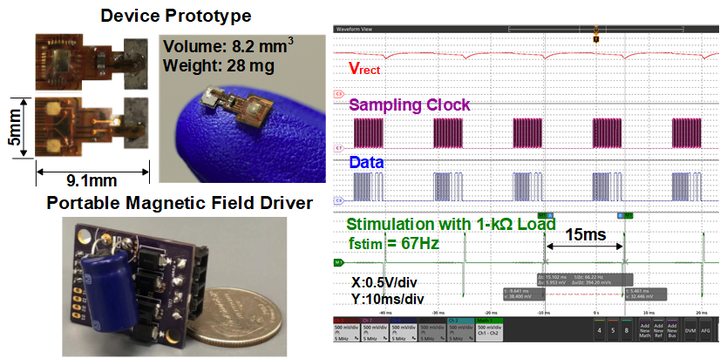
Abstract
Modulating the electrical activity in the nervous system has shown great potential for neuroscience research and clinical therapies. To reduce risks of infection and restrictions in subject mobility, neuromodulators must be miniaturized and untethered. Safe and reliable wireless power transfer and data delivery with the required size and power constraints is still one of the fundamental challenges in developing miniature neural interfaces. A few wireless neural implants powered by RF, inductive coupling [1]–[3], ultrasound [4], and optics [5] have been reported; however, existing solutions cannot simultaneously achieve implant miniaturization, system portability, functional flexibility, and subject mobility, while avoiding tissue heating due to body absorption of high-frequency EM waves [6], attenuation of mechanical waves crossing different mediums [7], limited penetration depth of light [5], or lack of controllability with magnetothermal nanoparticles [8]. In comparison, magnetoelectric (ME) transducers, which convert low-frequency (100kHz to 10MHz) AC magnetic fields into electrical energy via mechanical coupling between magnetostrictive and piezoelectric films (Fig. 34.3.1, top), are promising for powering biomedical implants by offering all the desired properties summarized in Fig. 34.3.1. At resonance, lead zirconate titanate (PZT)/Metglas-based ME films generate high output voltage $(textgreater 7mathrmV_mathrmpp)$ with low resistive source impedance (8000), under a magnetic field of less than 1mT, making it suitable for efficient energy harvesting. In this paper, we present MagNI (Magnetoelectric Neural Implant), the first untethered and programmable neural implant exploiting ME effects, which integrates a 1.5mm2 180nm CMOS SoC, an in-house built 4mmx2mm ME film, a single energy storage capacitor, and on-board electrodes onto a flexible polyimide substrate. It features: (1) a miniature physical dimension of 8.2mm3 and 28mg with only two discrete components added to the SoC (2) adaptive system control and data transfer mechanisms robust under source amplitude variations (1V variation tolerance and 0.2V modulation depth), (3) a best-in-class 90% chip efficiency due to its low static power down to 23.7µW, and (4) the capability to perform fully programmable bi-phasic current stimulation covering 0.05 to 1.5mA amplitude, 64 to $512mu mathrms$ pulse width, and 0 to 200Hz frequency ranges, suitable for a variety of clinical targets such as the spinal cord, the vagus nerve and the brain. The concept of a spinal cord stimulating system enabled by MagNI with a battery powered magnetic transmitter assembled on a wearable belt is shown in Fig. 34.3.1 (bottom left).